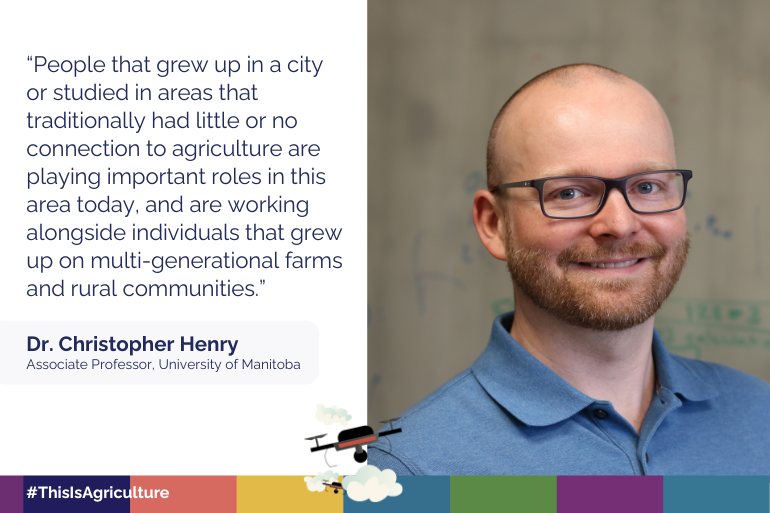
They say that necessity is the mother of invention, and the lack of available labeled data in digital agriculture is what has been guiding Dr. Christopher Henry’s research over the years. As an Associate Professor at the University of Manitoba Faculty of Science, Dr. Henry’s research focuses on the theory and application of machine learning in digital agriculture and remote sensing. He also teaches and inspires the next generation of scientists, while co-leading the TerraByte research group. Read on to learn about Dr. Henry and how he applies computing applications to digital agriculture.
Describe your job in one sentence.
My job is to solve problems and generate new knowledge while training and educating the next generation of scientists and specialized workers.
Where did you grow up?
I grew up in Winnipeg. While my childhood was in an urban environment, there was a farm in the family that I visited as a child.
What was your dream job when you were a kid?
I did not know what I wanted to do when I grew up, but I loved taking things apart to see how they worked, and solving riddles and problems. I wanted a job that was interesting and exciting.
What first piqued your interest in agriculture and agri-food?
My interest arose in 2016 when I saw that deep learning could have a big impact in the agriculture and agri-food industry. This led to my first work in the area via a collaboration with Northstar Robotics, which was a Winnipeg company that developed autonomous farming equipment.
What’s something that surprised you when you started working in digital agriculture?
I was surprised by the lack of available labeled data for developing deep learning applications. I assumed that, with the advent of precision agriculture in the 1990s and 2000s, there would be plenty of high-quality labeled data to develop deep learning applications. But the data either did not exist or was not freely available. This observation drives much of our work on dataset generation to this day.
What do you think would help digital agriculture develop and advance more quickly?
A good way to advance more quickly is to build public, industry, and government awareness about the need to innovate in the digital agriculture space and build on Canada’s agricultural leadership legacy. Moreover, a national strategy is needed. Australia has developed a wonderful digital agriculture strategy that focuses on investment in leadership, skills and training, data and governance, opportunities and value proposition, and connectivity and infrastructure. These are all areas Canada should be focusing on to develop and advance digital agriculture more quickly.
What’s the most interesting thing you see happening in digital agriculture right now?
It is the multidisciplinary approach to bringing about Agriculture 4.0. The best part of working in digital agriculture is that there is a need for people with a wide range of backgrounds, skills, and experience. People that grew up in a city or studied in areas that traditionally had little or no connection to agriculture are playing important roles in this area today, and are working alongside individuals that grew up on multi-generational farms and in rural communities. I find the opportunities created by this type of collaboration and research very exciting. I hope this inspires more young people – from all backgrounds – to pursue jobs, training, and education in digital agriculture.
How did you start collaborating with EMILI?
I had a research project with Sightline Innovation in 2015 to develop methods to augment labeled datasets for deep learning applications. The CEO of Sightline, Wally Trenholm, was working with Drs. Jo Kennelly and Frank Plummer to start a non-profit entity with the goal of positioning Winnipeg as a hub for artificial intelligence. My first introduction to what would become EMILI was a meeting between them, Jim Balsillie, and Dr. Annette Trimbee at the University of Winnipeg. Also present at this meeting was Dr. James Currie, Dr. Christopher Bidinosti, Dr. Herb Enns, Dr. Ian Mauro, and Chris Minaker. From there, Dr. Chris Bidinosti and I were invited to host a booth for EMILI’s launch event at Club Regent in February 2016.
The above groundwork ultimately led to Jacqueline Keena (EMILI Managing Director) inviting me to present a talk on deep learning and the farm of the future at the Protein Industries Canada Thought Leader Summit in 2018. This talk led to Keena, Dr. Bidinosti, and I submitting a proposal to Western Economic Development Canada (now known as PrairiesCan) that ultimately funded and paved the way for our digital agriculture collaborations with EMILI ever since.
This profile is part of EMILI’s This is Agriculture series, highlighting talented and diverse individuals across the digital agriculture sector. While individuals working in agriculture come from a variety of backgrounds, they share a common interest in growing and strengthening Canadian agriculture to ensure an environmentally and economically sustainable future for generations to come.
